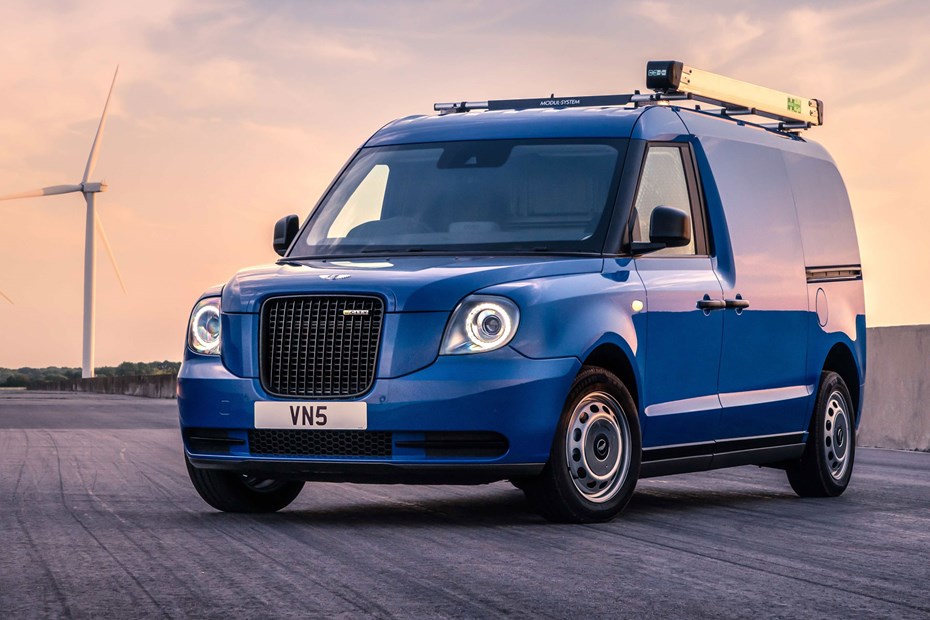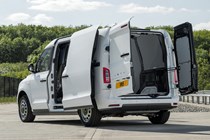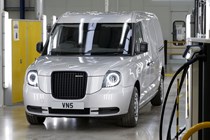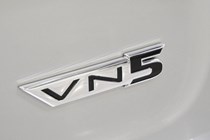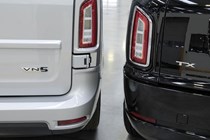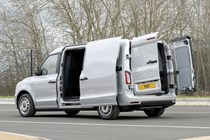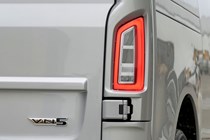UPDATE: We have now driven the LEVC VN5 electric van – see our full review!
The London Electric Vehicle Company has released technical specifications for its LEVC VN5 electric van, plus the pricing and trim level info. This British-built, range-extender electric van is based on the same vehicle platform and technology as the London Taxi, and will be on sale before the end of 2020.
With its distinctive appearance, innovative bonded-aluminium construction and a total driving range of over 300 miles, the LEVC VN5 is being pitched at businesses that want to clearly present a clean, green image – while also providing a vehicle with a longer-than-average working life, which we’ll cover in more detail below.
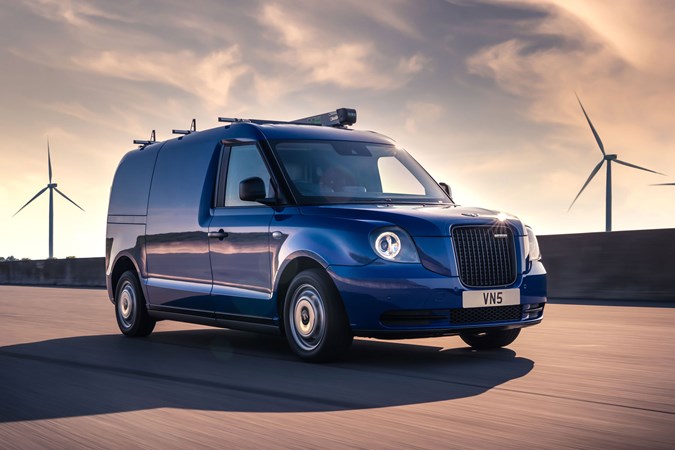
Running costs are projected to be as low as 2p per mile and it comes with an industry-leading five-year / 150,000-mile total vehicle warranty (eight years for the battery pack), helping to offset a high retail price. Strong secondhand residual value predictions help keep the starting price for monthly finance under £500 for a five-year contract with a 20,000-mile annual allowance.
Still, the price combined with a relatively modest load capacity and payload compared with conventional, diesel-powered medium vans means the taxi-based van is likely to be a niche product initially. Both DPD and Royal Mail have recently been testing engineering prototypes, however.
As well as driving this new model we have been following its development very closely, visiting the factory, meeting the CEO and spending time prodding and poking two sets of prototypes. On top of which, we’ve also spent a week driving the black cab it’s based on to see what that’s like.
Click the links below to jump straight to the section that most interests you, or keep reading for all the info on this intriguing new entrant into the electric van market.
- > What does VN5 stand for?
- > Who is LEVC?
- > Driving range
- > Aluminium construction
- > Will it be difficult to repair?
- > Service intervals and warranty
- > Practicality and load area
- > Payload
- > Trim levels and options
- > Cab design and comfort
- > Driving experience
- > Charging time
- > Running costs
- > Price
Why is it called the VN5?
Starting with the easy ones, eh? Following the pattern set by the taxis – which are labelled TX – the van is called VN because it’s short for ‘van’. The 5 part, meanwhile, references the load capacity, which is now confirmed at 5.5 cubic metres.
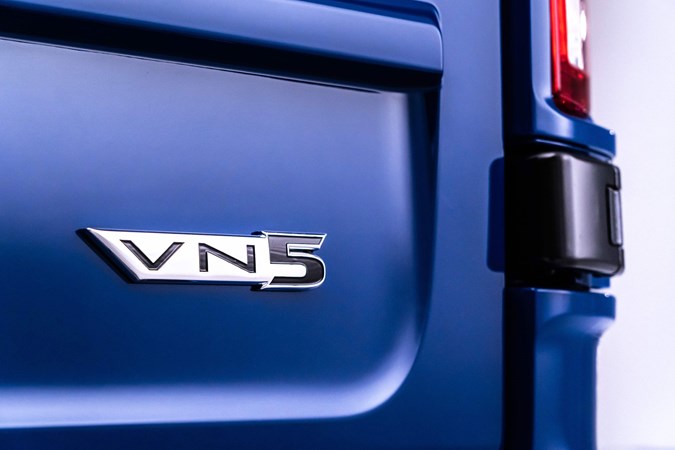
Prior to this, the vehicle had been officially referred to as the LEVC LCV – or simply the London Taxi van. The proper VN5 name was announced in March 2020 during our first factory visit, just before the van was due to make its public debut at the 2020 CV Show in April.
The cancellation of that event due to coronavirus put back LEVC’s publicity plans somewhat, but having visited the factory for a second time in July 2020, we’re assured despite COVID-19, production
Who is LEVC?
LEVC is the latest version of the business that was previously known as the London Taxi Company. As that name suggests, up until this point all it has ever made is the famous London Taxi – the typical black cab. They come in a much wider range of colours than that these days; a whole bunch of red ones have just been sold to Azerbaijan. No kidding.
The old London Taxi Company was purchased by Chinese automotive giant Geely in 2013, and then rebranded the London Electric Vehicle Company in 2017, just before it launched the current taxi model in January 2018.
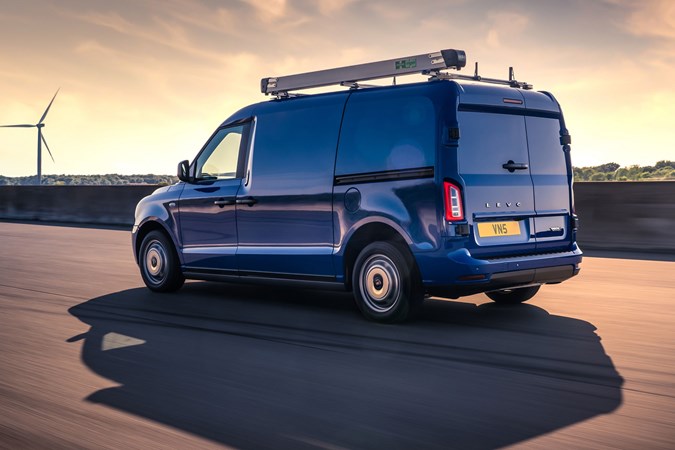
The name change reflected Geely’s plan to transform the firm from one that built a single, niche product into an electric commercial vehicle business. Production of the taxi continues – in fact, it doubled in 2019, though that only means 2,500 examples – but once construction of the van is in full swing, LEVC expects this to account for 70% of the vehicles it builds.
There are big ambitions for the new model, in other words.
Despite the London part of the name, the company – which has origins that date all the way back to 1908 – has been based in Coventry for the past 70 years. However, its ultra-modern new factory only opened in Ansty, near Coventry, in late 2017, making it the newest car-building plant in the UK.
What’s the driving range of the LEVC VN5 electric van?
The VN5 is powered by the same eCity range-extender electric drive as the TX5 taxi – similar to the system used in the Ford Transit Custom Plug-In Hybrid, except with a much longer battery-powered electric driving range, making it even more eco-friendly.
The latest official data on this electric-only driving range is 61 miles.
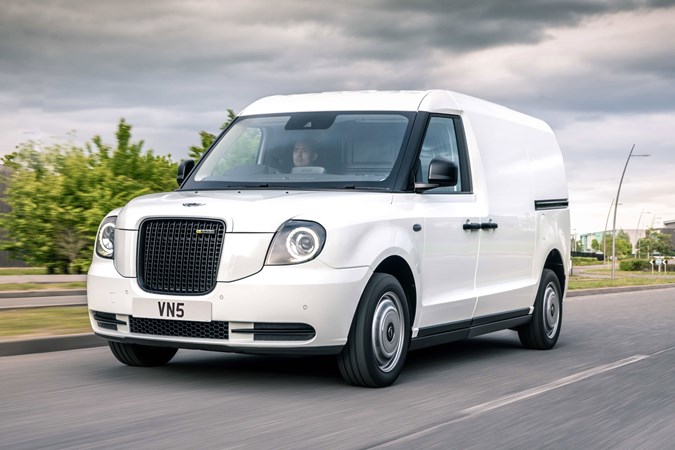
LEVC is pitching the VN5 as the perfect ‘delivery to door’ solution. This is in opposition to the so-called ‘last mile’ solutions that pure electric vans promise, because the range-extender function means that there’s also a 1.5-litre petrol engine under the bonnet at the front that can provide electricity for the electric motor that drives the rear wheels once the battery runs out.
This gives the VN5 a total claimed driving range of 304 miles
Why is it made out of aluminium?
The aluminium structure is the other especially innovative area of the VN5. Uniquely in the van sector, this is glued rather than welded together, as the gluing process is four times stronger with aluminium, apparently. Using aluminium helps keep weight down – important when you’ve got a 400kg battery pack on board – and promises to make it more durable.

The aluminium not only doesn’t rust in the same way as a traditionally built van, it can absorb twice the crash energy of mild steel. This structure is then covered by SMC panelling – this ‘sheet moulding compound’ is a composite material that’s ‘resistant to dents’ and said to ‘shrug off minor impacts’.
As a result, LEVC is predicting the VN5 will have twice the service life of a conventional steel van – and the reduced mechanical complexity of the range-extender drivetrain.
WIll it be difficult to repair?
LEVC says not – and hear it out. While these materials are new to the van world, they have been in use among cars for decades now – think of all the aluminium Jaguars there have been, for example – and any competent, modern bodyshop should be able to deal with fixing damage.
What are the service intervals and warranty?
For similar reasons, service intervals will be set at 25,000 miles, and the VN5 will be offered with a five-year / 150,000-mile warranty (eight years for the battery). For a small fee you can even extend this to six years / 200,000 miles (the battery cover stays at eight years, but is also extended to 200,000 miles).
How practical is it?
This is a tricky one. LEVC calls it a medium van, competing in the 1.0-tonne segment – which theoretically makes it a rival to vans such as the Ford Transit Custom and Volkswagen Transporter.
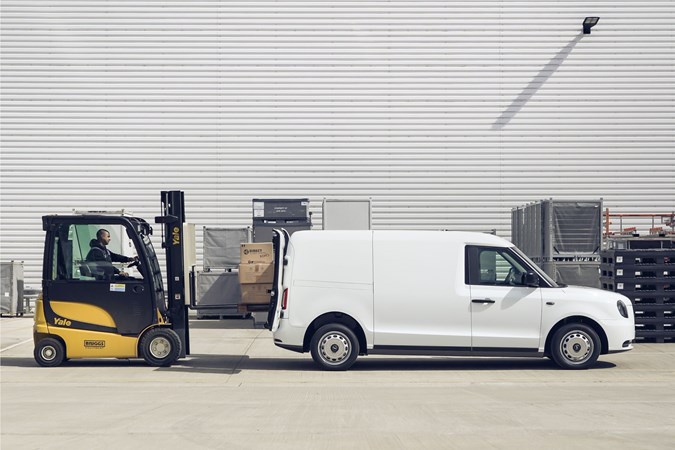
But at the same time, LEVC is placing a big emphasis on the VN5’s compact dimensions and extremely high level of manoeuvrability, which should make it ideal for driving in busy cities; being based on the taxi means it has a cleverly designed steering system that delivers an incredible 10.1m turning circle, while the roof height has been kept down to 1.99m to make it compatible with most car parks and urban loading docks.
As a result, the load space isn’t that generous. Overall volume of the single bodysize that’s been announced so far is 5.5 cubic metres. That’s significantly smaller than the 6.0 cubic metres the smallest Transit Custom can carry – but more than the smallest Renault Trafic (5.2 cubic metres) and mid-size Citroen Dispatch (5.3 cubic metres).
The design does its best to maximise practicality within these constraints, though. The load floor is 2.4m long, and will take two full-size Euro pallets, while the 1,038mm side door opening means you can load a pallet through this as well.

The sides of the van taper only slightly towards the roof and the bulkhead intrudes only slighty into the load area, so the space itself is reasonably squared-off and practical. Width between the rear wheel arches is around 1,120mm, and the rear door opening is 1,275mm wide.
The rear doors are split 60:40 for added access practicality, and can open to 180 degrees if needed. The van will be offered with single, double or no side doors, depending on customer requirements.
However, because the electric motor is mounted within the rear subframe, the load floor has to be high in order to clear it – giving the VN5 an unusually high loading height. I’m 5’11”, and the rear bumper is nearly as far from the ground as my knees, and there’s no step at the back to help you climb aboard; you will find one at the side door, though.
Full dimensions and payload info is available on our dedicated LEVC VN5 dimensions page.
What’s the payload of the LEVC VN5?
LEVC says the VN5 will carry a maximum payload of 830kg – though this will be lower for higher specification models.
Not bad versus a pure electric small van, such as the Nissan e-NV200 or Renault Kangoo ZE, but a little way off the best a conventional diesel-powered medium van can manage – with the best in this sector now capable of carrying nearly 1,500kg.
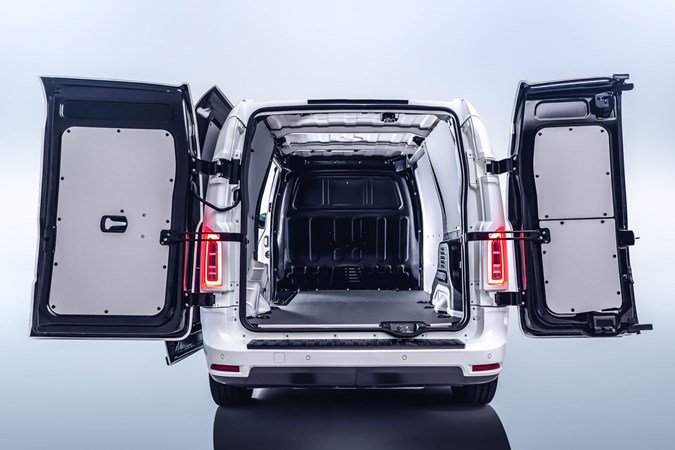
LEVC argues that its research shows that 39% of vans are only ever a quarter full. Fine if you’re a delivery driver, perhaps not so great for the construction industry.
There are plenty of pure-electric vans that will carry more, too, with the Vauxhall Vivaro-e and related Citroen e-Dispatch and Peugeot e-Expert swallowing over 1.2-tonnes (1,200kg).
Are there different versions available?
While LEVC is only offering a single body size, the VN5 is available in a choice of three trim levels – Business, City and Ultima – supplemented by option packs. LEVC has also already been in touch with accessory suppliers and converters, ensuring that there are racking, lighting and other solutions ready to go when the vehicle properly launches into the market.
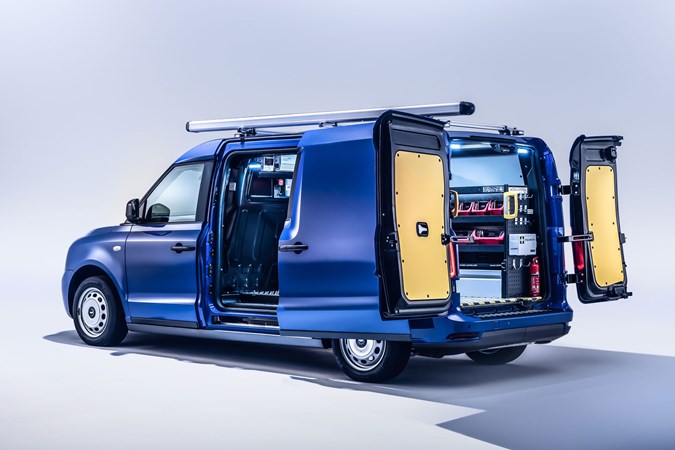
Standard equipment is generous to say the least, with even the entry-level VN5 Business model coming with autonomous emergency braking, four airbags, dual-zone climate control, 9.0-inch touchscreen infotainment system and cruise control.
Upgrading to a VN5 City adds a heated windscreen, front and rear parking sensors, two more airbags and a lane-departure warning system. In addition to this, the VN5 Ultima features luxury seats, a rear-view camera and metallic paint.
There are six option packs – though only the Comfort (luxury seats with storage, sat-nav, heated windscreen) and Safety (road-sign recognition, intelligent speed limiter, lane-departure warning, curtain airbags) have been detailed so far. Accessories include seat covers, floor mats and device holders.

All models come with 50kW DC fast charging capability and an 11kW AC charger; Ultima adds a 22kW AC charger, which is an optional upgrade for other models in the range. With two sets of charging ports at the front of the vehicle, under flaps either side of the grille, LEVC says the VN5 is better equipped than any competitor.
What’s the VN5 like inside the cab?
Again, the floor is high, which might trouble some people getting in, and overall the cab feels rather compact and perhaps even slightly claustrophobic. The doors are very close to you, for instance, so it feels narrow, too.
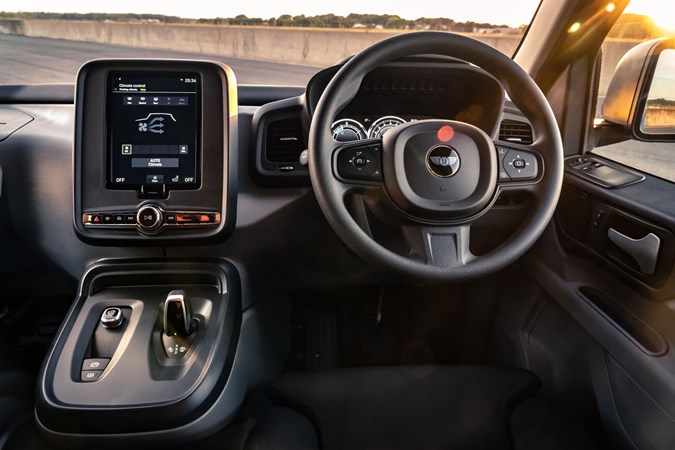
Build and material quality seems more than acceptable, even on the early prototypes we’ve seen so far. And the VN5 does have reach and rake adjustable steering plus a number of unusual features – including a digital instrument cluster and a large central infotainment screen.
These parts are all familiar from the taxi, which in turn means they’re similar to what you’ll find in a Volvo – Geely also owns this famous Swedish brand.
What’s the taxi like to drive?
The TX eCity is one of the most surprising vehicles we’ve driven in ages.
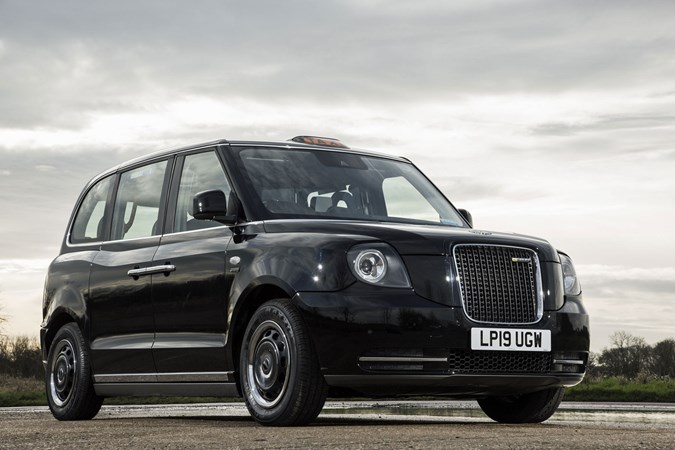
The taxi is remarkably comfortable and good fun to drive. The 110kW (150hp) electric motor – which is the same in this as in the van – delivers really impressive performance at both town centre speeds and on the motorway, and the batteries genuinely seem to last a decent length of time.
Adding a substantial payload will understandably impact the performance and the electric range. But it certainly feels powerful enough to cope with plenty of weight, and being a hybrid means you can always fall back on the petrol engine should you need to travel further than the batteries will allow.
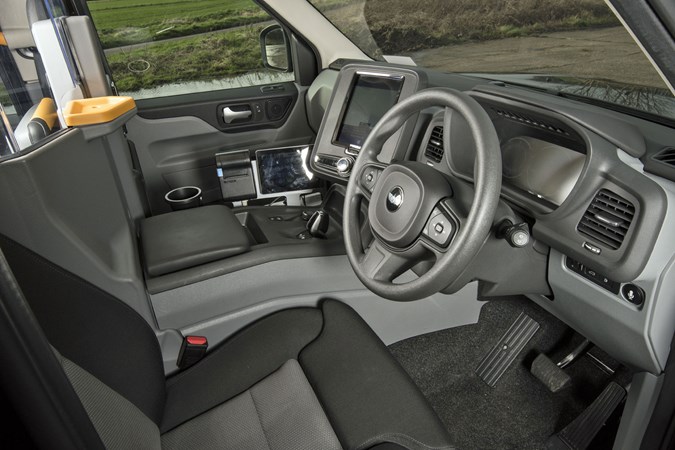
All told, we’re now certain that the van will represent a real and proper alternative to mainstream models from more familiar van makers.
Tell me more about the driving range – and how long will it take to charge?
The eCity range-extender system only ever drives the rear wheels using the electric motor, there is no direct connection between the petrol engine and the wheels at all. This is the reason LEVC prefers to call it a range-extender rather than a plug-in hybrid.
With a 31kWh battery pack below the front seats (the safest place in crash testing, we’re told), the VN5 will go a claimed 61 miles on battery power alone. That’s a WLTP figure, so to the latest standards, but not fully ratified just yet.
Need to go further before you can charge again? Don’t worry. With a 36-litre fuel tank, the petrol engine can generate enough extra electricity for a total range of 304 miles (slightly more than the taxi). That’s better than the rival Transit Custom Plug-In Hybrid, and any pure electric van – though also doesn’t account for a full payload, which will dent the range of both power sources considerably.
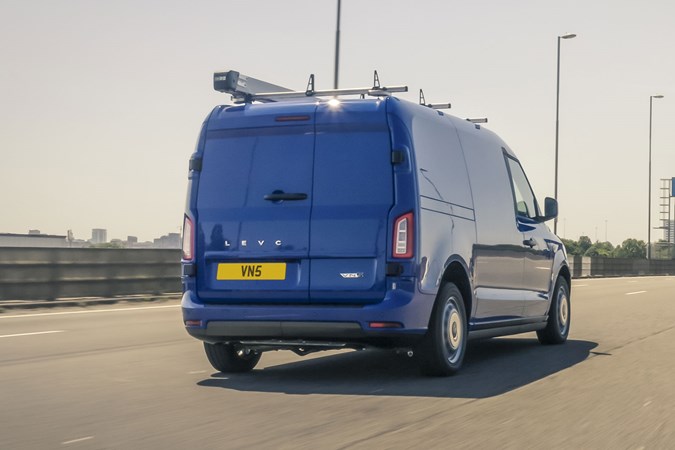
Still, that’s the same with all vans, and at least the VN5 is also fully equipped to take advantage of fast charging; with the option to accept a 50kW DC charge it will go from flat to full in 30 minutes – again, way faster than any rival.
So fast that LEVC says some businesses will be able to get a full charge in during the time it takes to get the van fully loaded.
Even so, with the total range and flexible drivetrain, the firm says the VN5 will do a typical 47-mile round trip from Heathrow to central London six times before needing fuel and a recharge – something no pure-electric rival can compete with.
Will it be very expensive to run?
Quite the opposite. LEVC has data from the taxis it makes using the same eCity drivetrain, and these have now collectively covered over 100 million miles. In just two years.
This not only suggests the VN5 shouldn’t have any major reliability concerns, the data shows that with a full charge costing only £3, and the reduced cost per litre of petrol versus diesel, the latest taxi saves drivers around £110 per week compared with the vehicle it replaced.
That’s over £17million in fuel costs overall, not to mention a saving of 17.5-million litres of fuel and 30,000 tonnes of CO2.
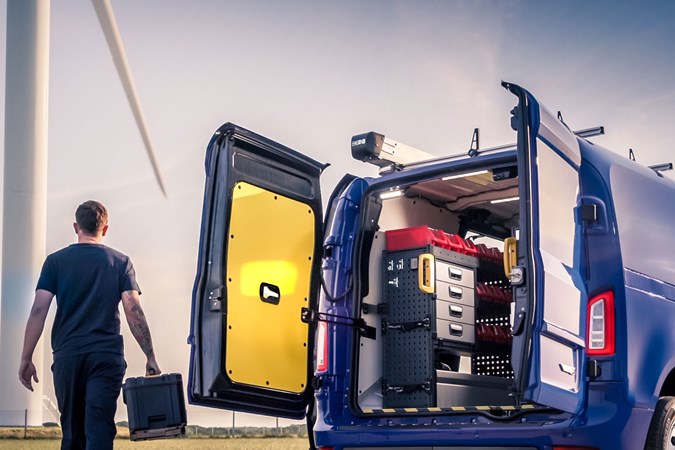
Further to this, using an electric-vehicle optimised electricity supplier such as Octopus Energy, LEVC believes the VN5 can be fully charged for less than £2, giving it running costs of as little as 2ppm (pence-per-mile); a diesel alternative typically costs 11ppm.
As a zero-emissions vehicle (when running on electricity alone), the van will also be exempt from the London ULEZ charge, a saving of £12.50 per day. Expect similar savings when other cities introduce their versions of this scheme. And as its combustion engine runs on petrol, it won’t fall foul of any diesel bans, either.
We were a little concerned about servicing, given LEVC isn’t a massive brand. But have been assured that the aim is for no customer to find themselves more than 45 minutes for the nearest service centre.
How much is the LEVC VN5 and when does it go on sale?
The starting price for the VN5 is £46,500 (plus VAT but before any grants or other discounts). LEVC has also announced that Contract Hire rates will start at £493.92 (plus VAT), for a 60-month contract for 20,000 miles of driving per year.
Whether the image opportunity, the low running costs and the longevity of the van are enough to make it worth your while, well, that’s a decision only your business can make.
£46.5k is a lot of money for a medium van, especially when you consider the pure-electric Mercedes-Benz eVito and Volkswagen eTransporter both start around £40k. Neither of these offers anything like the total driving range of the VN5, though – and its 61-mile electric range isn’t even far off the eTransporter’s 82-mile total range (the eVito manages 93 miles).
Also read:
>> LEVC VN5 electric van review
>> The Parkers guide to electric vans
>> Future electric vans coming soon
>> The best electric vans you can buy now



